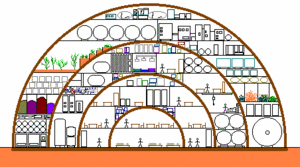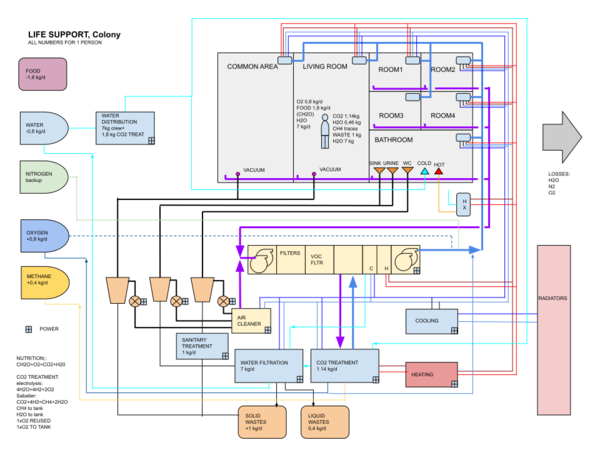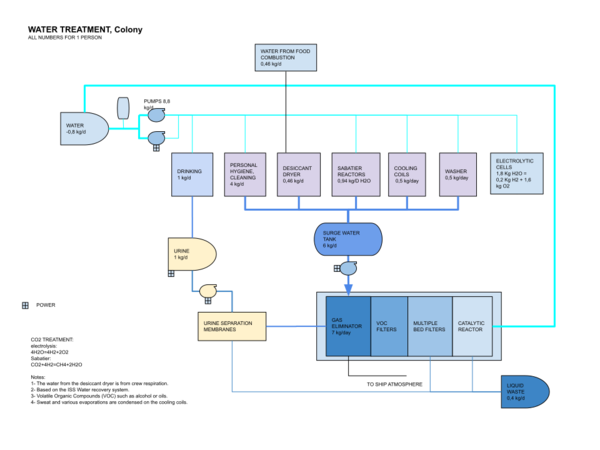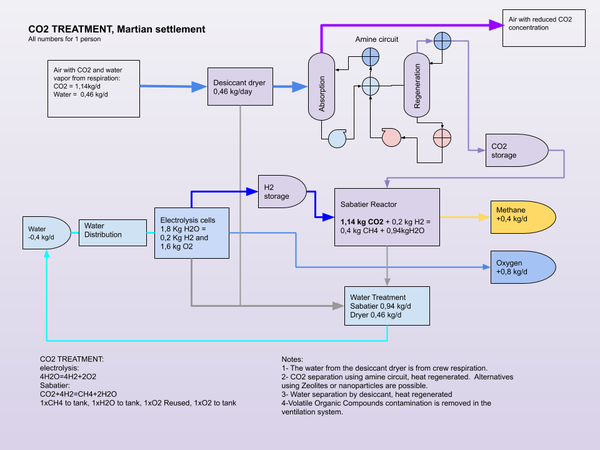Difference between revisions of "Life support"
| Line 8: | Line 8: | ||
*[[CO2|CO<sub>2</sub>]] must be removed. | *[[CO2|CO<sub>2</sub>]] must be removed. | ||
*Food must be provided. | *Food must be provided. | ||
| − | *The temperature inside the habitat must be comfortable.[[File:Colony life systems.svg|thumb|600x600px]] | + | *The temperature inside the habitat must be comfortable.[[File:Colony life systems.svg|thumb|600x600px|A complete life support system. All quantities for 1 person. This is just one of the many possibilites for this type of system,]] |
==ISS-like systems== | ==ISS-like systems== | ||
| Line 21: | Line 21: | ||
The first Martian settlement will probably be much smaller than Biosphere 2, making it even harder to keep a constant oxygen level. This article discusses solutions to mitigate this issue. | The first Martian settlement will probably be much smaller than Biosphere 2, making it even harder to keep a constant oxygen level. This article discusses solutions to mitigate this issue. | ||
[[File:Colony water treatment.svg|thumb|600x600px]] | [[File:Colony water treatment.svg|thumb|600x600px]] | ||
| + | [[File:Colony CO2 treatment.png|thumb|600x600px]] | ||
===Buffering the gases=== | ===Buffering the gases=== | ||
| Line 27: | Line 28: | ||
===Constant artificial lighting=== | ===Constant artificial lighting=== | ||
| − | |||
| − | |||
Parts of the oxygen producing [[greenhouse]]s may be lit at night, which requires [[energy storage|stored electrical energy]]. The stored energy must be large enough to cover a few months of dust storms, unless nuclear reactors are used. [[wind turbine]]s may help to produce part of the needed energy. | Parts of the oxygen producing [[greenhouse]]s may be lit at night, which requires [[energy storage|stored electrical energy]]. The stored energy must be large enough to cover a few months of dust storms, unless nuclear reactors are used. [[wind turbine]]s may help to produce part of the needed energy. | ||
==Open Issues== | ==Open Issues== | ||
| + | [[Image:carbon_cycle_simplified.png|thumb|right|300px|The Carbon Cycle (simplified)]] | ||
*What is necessary to build such a water buffer? How much water is needed? How can the active surface of the water be extended (rinsing over lava stone, spraying in the air, etc.) and what amount of energy is needed to keep this technology running? | *What is necessary to build such a water buffer? How much water is needed? How can the active surface of the water be extended (rinsing over lava stone, spraying in the air, etc.) and what amount of energy is needed to keep this technology running? | ||
[[Category:Life Support Systems]] | [[Category:Life Support Systems]] | ||
Revision as of 08:05, 11 May 2019
Live support systems are an essential and necessary part of a Martian settlement, since the natural Martian environment does not allow human beings to survive. More information on this topic is included in How living on Mars will be different than living on Earth.
Contents
Requirements
- Water is the most important requirement. No water no life.
- Oxygen must be combined with nitrogen to create breathing air inside the habitat.
- CO2 must be removed.
- Food must be provided.
- The temperature inside the habitat must be comfortable.
ISS-like systems
The life support system on the ISS is optimized to low weight. It must be fuelled with large amounts of energy and it requires a constant replenishment with consumables.
Near-natural systems
On Mars we will not be able to maintain a life support system that needs consumables. The alternative is a near-natural carbon cycle with the growing of food and producing oxygen at the same time.
The challenge is the day and night rhythm as well as the lasting dust storms. Oxygen can only produced with light, either sunlight or artificial light. During the night or during a dust storm there is not enough sunlight, neither for direct lighting for the plants nor for photovoltaic powered electric light. The Biosphere 2 experiment has shown significant deviations from good oxygen conditions due to the day and night rhythm.
The first Martian settlement will probably be much smaller than Biosphere 2, making it even harder to keep a constant oxygen level. This article discusses solutions to mitigate this issue.
Buffering the gases
Big tanks of water may be used to buffer some amount of oxygen as well as CO2, since those gases are soluble in water according to Henry's law. A good side effect is the heat capacity of the water, helping to keep a comfortable temperature in the settlement.
Constant artificial lighting
Parts of the oxygen producing greenhouses may be lit at night, which requires stored electrical energy. The stored energy must be large enough to cover a few months of dust storms, unless nuclear reactors are used. wind turbines may help to produce part of the needed energy.
Open Issues
- What is necessary to build such a water buffer? How much water is needed? How can the active surface of the water be extended (rinsing over lava stone, spraying in the air, etc.) and what amount of energy is needed to keep this technology running?











